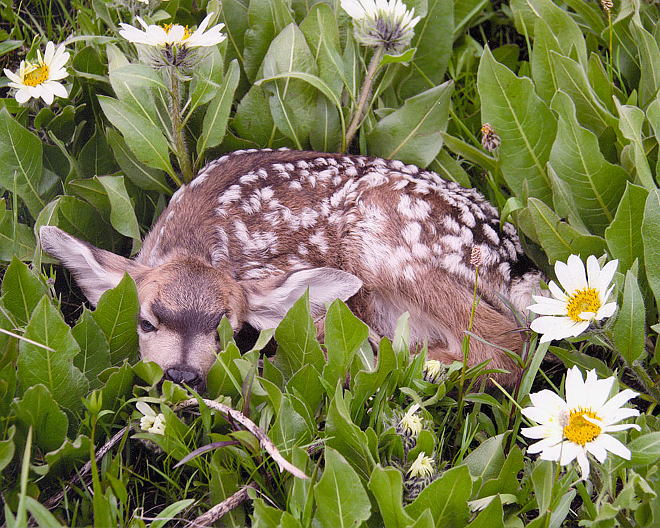|
Spring is baby season for all things wild |
|
May 8, 2017 |
 |
By Mike Demick
IDFG Conservation Information Supervisor
Being the peak time for wildlife to have their
young, the Idaho Fish and Game offers this
simple suggestion to those well-intentioned
people that discover baby animals that appear to
be abandoned: Leave them alone.
Each spring a myriad of baby birds, ducklings,
goslings, squirrels, fawn mule deer, calf elk,
baby raccoons and baby rabbits are taken from
the outdoors and brought to Fish and Game. The
unfortunate part of these well-intended
"rescues" is that in most cases, the animal was
not lost, abandoned or orphaned.
"Just because the mother is not present, doesn't
mean the youngster isn't being properly cared
for,” cautions Clay Hickey, Fish and Game
wildlife manager based in Lewiston. “If you
encounter young wildlife that seems abandoned,
it’s best to leave it alone.”
Many wild animal mothers often leave their
offspring alone for extended periods of time to
feed, rest or to find food for their young. As
baby birds mature, they often leave the nest in
their efforts to hone their flying skills. Adult
birds continue to feed their offspring until
such time that the young birds can survive on
their own.
The survivors either smarten up fast or quickly
fade from the scene. While this seems
unfortunate or cruel, this is a normal
occurrence in nature.
Mammals such as deer, elk and pronghorn
routinely leave their young ones in a secure
location, moving off to feed and returning later
- sometimes several hours later - to quickly
feed their young and leave again. For the first
few weeks these offspring have a survival
strategy of remaining camouflaged, motionless
and scent-free to avoid predators. This allows
the lactating mom to forage away from their
young for much of the day.
"Resisting the urge to pick up that deer fawn
may seem cruel, but it’s the right thing to do,”
Hickey added. "The mother is probably nearby
just waiting for you to leave.”
Many times when well-meaning people take young
wildlife from the wild, their chances of
survival are not improved, but lessened. Most do
not survive well in captivity and many lack
survival skills to allow release back to the
wild.
Fish and Game has two alternatives when dealing
with animals removed from the wild.
Wildlife rehabilitators can attempt to raise the
animal and return it back in the wild, but this
option sometimes fails because the majority of
young animals brought in are often in poor
condition and providing the proper nutrition is
a huge challenge. The animals that do make it
generally have no survival skills and have often
unnaturally formed bonds with humans. Fish and
Game can attempt to place the animals in zoos,
but most zoos now refuse to take the animals
because of crowding and potential disease
concerns.
“The reality is that the youngster’s fate is
usually sealed – in a bad way - when it is
‘rescued’ from the wild,’ Hickey says.
If you find a baby bird, duckling, squirrel or
other critter, the best approach is to leave it
undisturbed. Only move the animal if it is in
harm's way, like found wandering in the road,
for example.
Placing baby birds in a shrub or on a tree
branch will help them avoid house cats. Don't
fret about getting your scent on a baby bird.
The myth that birds will abandon their offspring
once humans have handled them is just that: a
myth. Most birds lack a sense of smell.
Note the location carefully and contact the
nearest Fish and Game office who will able to
advise you on the best action to take.
Bats are also currently migrating back from
their wintering grounds and as they move
through, they often roost in places that might
seem odd, like low on the side of buildings,
tree trunks, and even in people's gardens.
If a bat is hanging upside down in its normal
position, and not on the ground, leave the bat
alone and make sure that pets and children do
not disturb it. Do not touch the bat. If you
find a grounded or injured bat, contact your
nearest Fish and Game office.
In addition, do not plan to raise wild animals
on your own. Young wild animals require special
care and feeding that is beyond what the average
household is prepared to manage. Additionally,
possession of most species of wildlife taken
from the wild is illegal in Idaho.
In the spring when wildlife reproduction is at
its peak, you may have the good fortune to
observe a nest of birds or a litter of young
mammals with no adult in sight. Enjoy the sight
but if nothing is obviously amiss, it is best to
leave young wildlife alone. |
|
Questions or comments about this
article?
Click here to e-mail! |
|
|
|
|

